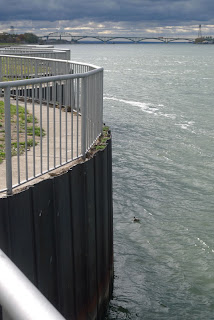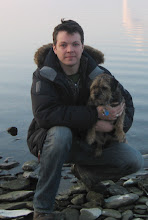This past week I've been birding locally and waiting for another rarity to be reported. November is the best month for Western vagrants in New York, and I'm expecting at least one or two birds to show up from the west coast. Last week there was a Say's Phoebe reported in Batavia, but it didn't stick around so I couldn't chase it (Batavia is near Buffalo, about 6 hours by car). Then on Monday another bird showed up...Sabine's Gull near Niagara Falls. I had to work Tuesday, so I couldn't go up right away, but on Tuesday night at about 8:30pm I got in the car and aimed north. Around one in the morning I stopped and slept for a few hours, and then continued around five, reaching Squaw Island at 8am. It was beautiful but cold, with snow flakes swirling in the air and fresh snow on the ground. I had on all my hardcore winter gear...parka, thermal underwear, turtle, ski gloves, and that kept the weather out. Being comfortable is critical, since these chases can often mean long hours of waiting in the wind and weather. The bird wasn't immediately apparent, and I misread the emails about where it had been seen, so I headed upriver along a bike path rather than downstream to it's last reported location. The river separates New York and
Canada, and as I walked under the Peace Bridge I could see the Maple Leaf flag flying overhead. There was a big congregation of birds about a mile up towards the head of the river, so I went that way and found a nice flock of Bonapartes Gulls massed and feeding in the fridgid water. Along the shore were Bufflehead, mixed ducks, and a single Snow Bunting, my first of the season. The crisp air and the birds reminded me of my trips at the beginning of the year, and the pleasure I'd had of scanning the flocks of gulls for an odd bird all came back in a rush. My scanning was unproductive, though, so I turned back and headed back downstream. As I walked I saw a little white bird feeding in the water near shore, and saw instantly that it was a phalarope. I photographed it and got good looks, and then headed back to my car to make a positive ID from the photos...I knew it was Red-Necked or Red Phalarope, but wanted to make sure of which. The ID turned out to be tricky for me, and I'm not very experienced with these birds, so long-story-short I decided on a probable Red-Necked (this was the more likey bird), and called Willie D'Anna to let him know and, if the bird was rare enough for the area, to get the word out. Willie did and I later found out that it was in fact a Red Phalarope, a very unusual bird.
Willie also corrected my misimpressions about where the Sabines Gull should be, so I went downstream on the hunt. I saw another birder ahead of me, but I was taking my time and didn't catch up to him right away. I had seen a flock of Bonapartes Gulls across the river, and spent some time looking through them for the bird, as well as admiring and photographing some gulls that were on the near shore. Still no Sabines. I finally reached the other birder as he got to his car, and after a little chit-chat he asked "Did you see the Sabines?". I had walked right by it! I ran back, scenarios of the bird flying off and never being seen again running through my head, and  there, not three feet from the shore, was the Sabines, bobbing in the eddies. I had been so focused on the far shore and on the gulls in flight, I hadn't thought to look right at my feet. The gull was unbelievably tame and cooperative...several times it floated directly under me, not ten feet away, as I snapped away with my camera. It would bob downstream, picking food out of the water, and then fly back up
there, not three feet from the shore, was the Sabines, bobbing in the eddies. I had been so focused on the far shore and on the gulls in flight, I hadn't thought to look right at my feet. The gull was unbelievably tame and cooperative...several times it floated directly under me, not ten feet away, as I snapped away with my camera. It would bob downstream, picking food out of the water, and then fly back up  and repeat the process. I saw the famous "three wedges" pattern on its wings as it flapped upstream, and then got amazing looks at it's back and head as it floated past.
and repeat the process. I saw the famous "three wedges" pattern on its wings as it flapped upstream, and then got amazing looks at it's back and head as it floated past.
I spent a while with the Sabines, and then headed back to Buffalo and celebrated my 343rd bird of the year with hot dogs and onion rings at Ted's, a famous local eatery. I had a seven hour drive back, and I broke it up by stopping at Montezuma Wildlife Management Area, where there were thousands of Ring-Necked ducks, as well as American Wigeon, Coots, Green Winged Teal, Pintails, and a variety of other ducks. One interesting surprise was a pair of juvenile Pectoral Sandpipers, who stopped briefly on a mud flat before flying on, no doubt feeling behind schedule on this late date in migration. The movement of the ducks on the water, the snowy landscape highlighting the remaining autumn-leaved trees, the chill wind blowing into the open car window and the warmth of the car heater, all put me in a peaceful state of mind that lasted the long drive back to Brooklyn.

























